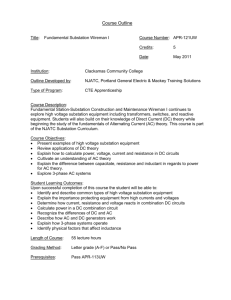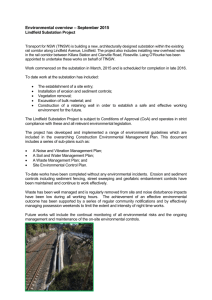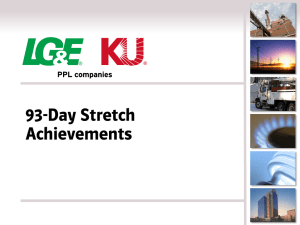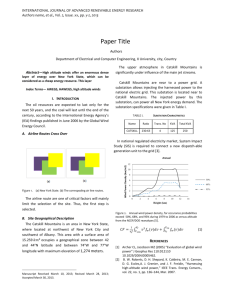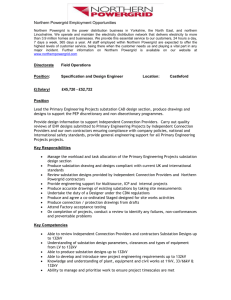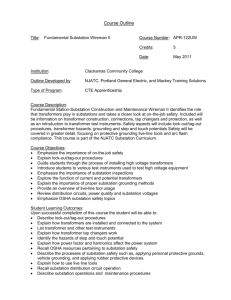Change Course APR 112UW Outline.doc
advertisement
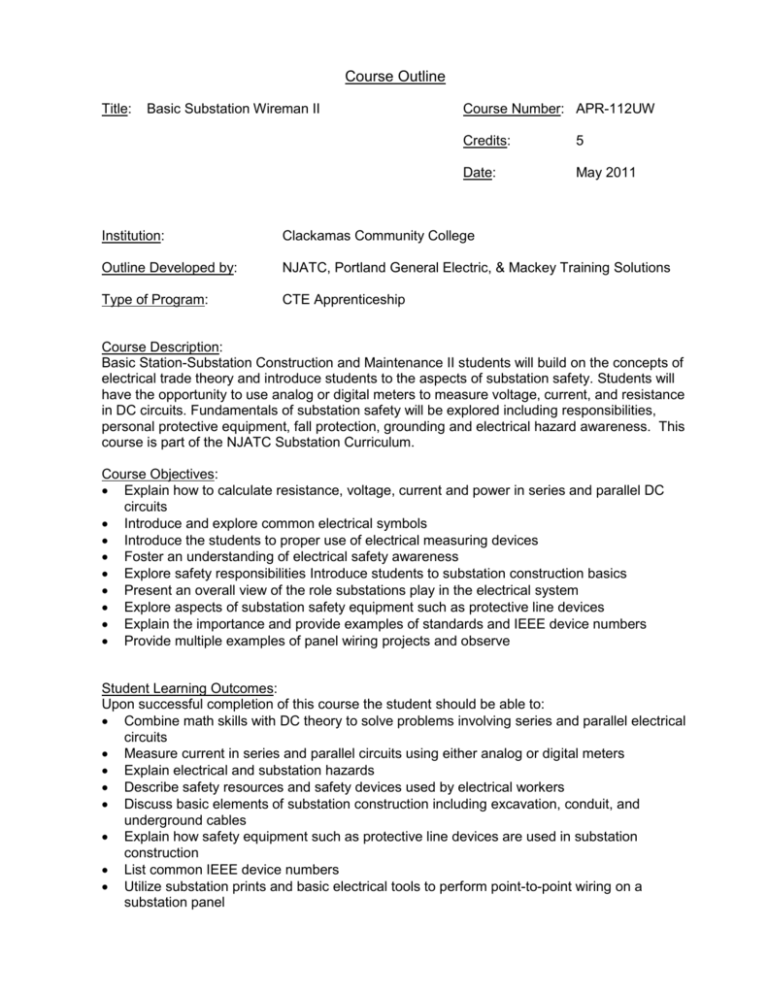
Course Outline Title: Basic Substation Wireman II Course Number: APR-112UW Credits: 5 Date: May 2011 Institution: Clackamas Community College Outline Developed by: NJATC, Portland General Electric, & Mackey Training Solutions Type of Program: CTE Apprenticeship Course Description: Basic Station-Substation Construction and Maintenance II students will build on the concepts of electrical trade theory and introduce students to the aspects of substation safety. Students will have the opportunity to use analog or digital meters to measure voltage, current, and resistance in DC circuits. Fundamentals of substation safety will be explored including responsibilities, personal protective equipment, fall protection, grounding and electrical hazard awareness. This course is part of the NJATC Substation Curriculum. Course Objectives: Explain how to calculate resistance, voltage, current and power in series and parallel DC circuits Introduce and explore common electrical symbols Introduce the students to proper use of electrical measuring devices Foster an understanding of electrical safety awareness Explore safety responsibilities Introduce students to substation construction basics Present an overall view of the role substations play in the electrical system Explore aspects of substation safety equipment such as protective line devices Explain the importance and provide examples of standards and IEEE device numbers Provide multiple examples of panel wiring projects and observe Student Learning Outcomes: Upon successful completion of this course the student should be able to: Combine math skills with DC theory to solve problems involving series and parallel electrical circuits Measure current in series and parallel circuits using either analog or digital meters Explain electrical and substation hazards Describe safety resources and safety devices used by electrical workers Discuss basic elements of substation construction including excavation, conduit, and underground cables Explain how safety equipment such as protective line devices are used in substation construction List common IEEE device numbers Utilize substation prints and basic electrical tools to perform point-to-point wiring on a substation panel Length of Course: 55 lecture hours Grading Method: Letter grade (A-F) or Pass/No Pass Prerequisites: Pass APR-111UW Major Topic Outline: UNIT 1-3 (NJATC DC Theory Workbook J202SW.H Used for Below Lessons) Electrical Energy Sources Electrical Switches Conductors, Conductor Resistance, and Wattage Loss Introduction to Electrical Devices The Series Circuit Understanding and Calculating Resistance in DC Series Circuits How Current Reacts in DC Series Circuits How Voltage Functions in DC Series Circuits How to Calculate Power in DC Series Circuits How Current Reacts in DC Parallel Circuits Understanding Resistance in DC Parallel Circuits How Voltage Functions in DC Parallel Circuits How to Calculate Power in DC Parallel Circuits Understanding the Principles of Magnetism UNIT 1-6 The Electric System Introduction to Substations Substation Construction – Foundations Working in Excavation and Trenches Excavating the Trench Laying Conduit/Building Duct Banks Manholes and Hand Holes Trench Encasement, Backfill and Compaction Cable Types Substation Construction – Underground Power Cables Pulling Cable Installing Cable in an Underground Vault/Manhole Substation Construction-Ground Grids Exothermic Welding Wiring Lab Standards and Device Numbers CCC AAOT/ASOT GENERAL EDUCATION OUTCOMES COURSE OUTLINE MAPPING CHART APR-112UW Basic Substation Wireman II Course Title and Number: Mark outcomes addressed by this course: Mark “C” if this course completely addresses the outcome. Students who successfully complete this course are likely to have attained this learning outcome. Mark “S” if this course substantially addresses the outcome. More than one course is required for the outcome to be completely addressed. Students who successfully complete all of the required courses are likely to have attained this learning outcome. Mark “P” if this course partially addresses the outcome. Students will have been exposed to the outcome as part of the class, but the class is not a primary means for attaining the outcome and assessment for general education purposes may not be necessary. As a result of completing the AAOT /ASOT general education requirements, students will be able to: WR: Writing Outcomes 1. Read actively, think critically, and write purposefully and capably for academic and, in some cases, professional audiences. 2. Locate, evaluate, and ethically utilize information to communicate effectively. 3. Demonstrate appropriate reasoning in response to complex issues. SP: Speech/Oral Communication Outcomes 1. Engage in ethical communication processes that accomplish goals. 2. Respond to the needs of diverse audiences and contexts. 3. Build and manage relationships. MA: Mathematics Outcomes 1. Use appropriate mathematics to solve problems. 2. Recognize which mathematical concepts are applicable to a scenario, apply appropriate mathematics and technology in its analysis, and then accurately interpret, validate, and communicate the results. AL: Arts and Letters Outcomes i 1. Interpret and engage in the Arts & Letters, making use of the creative process to enrich the quality of life. 2. Critically analyze values and ethics within a range of human experience and expression to engage more fully in local and global issues. SS: Social Science Outcomes 1. Apply analytical skills to social phenomena in order to understand human behavior. 2. Apply knowledge and experience to foster personal growth and better appreciate the diverse social world in which we live. SC: Science or Computer Science Outcomes 1. Gather, comprehend, and communicate scientific and technical information in order to explore ideas, models, and solutions and generate further questions. 2. Apply scientific and technical modes of inquiry, individually, and collaboratively, to critically evaluate existing or alternative explanations, solve problems, and make evidence-based decisions in an ethical manner. 3. Assess the strengths and weaknesses of scientific studies and critically examine the influence of scientific and technical knowledge on human society and the environment. CL: Cultural Literacy Outcome ii 1. Identify and analyze complex practices, values, and beliefs and the culturally and historically defined meanings of difference. IL: Information Literacy Outcomesiii 1. Formulate a problem statement. 2. Determine the nature and extent of the information needed to address the problem. 3. Access relevant information effectively and efficiently. 4. Evaluate information and its course critically. 5. Understand many of the economic, legal, and social issues surrounding the use of information. P P P P P P P P P P P P P P P “Arts and Letters” refers to works of art, whether written, crafted, designed, or performed and documents of historical or cultural significance. ii Must be embedded in a course that meets the outcomes for Arts and Letters, Social Science, or Science/Computer Science. iii Must be embedded in the general education required Writing courses. Revised 2010-2011 to reflect Statewide AAOT outcomes i
